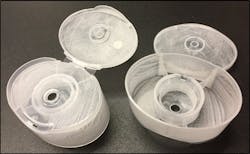Filling, foaming offer options for manufacturers looking to stretch resin
By Karen Hanna
Skyrocketing resin prices are driving demand for a solution proponents say provides addition through subtraction — cost savings, faster cycle times and reduced resin usage, all from augmenting resin with fillers and foaming agents.
“I usually tell guys, ‘Look, I can save you money when it’s priced at 50. Imagine what I can do for you when resin goes up to 90, which invariably it does once a year at least. This isn’t the first time. This is the largest spike we've ever seen,” Sotos said.
According to Esteban Sagel, a principal at Chemical and Polymer Market Consultants, which tracks the materials market, a Gordian knot of interlocking issues, culminating in the winter storm that blasted Texas in February, has created a stranglehold on resin supply. As a result, some resins now cost nearly three times more than they did last year.
Fillers and foaming agents, like those supplied by iD Additives, can be added as part of the manufacturing process tobe able to make more parts with the“Our goal is always 10 percent,” said Ron Bishop, technical manager at iD Additives, in terms of cutting resin use. Cycle times often drop 15 percent.
Eligible candidates once had to have a minimum wall thickness of 0.19 inch, Bishop said; now, even parts with wall thicknesses as thin as 0.028 can be filled or foamed — or both.
“It’s come a long way from back in the day. Back in the day, the only thing people wanted to foam was quarter-inch or thicker parts. With our technology, we’re able to do general applications and, even in blown film, extrusion, we're able to do some amazing [things] ... like a 25-mil sheet and take like 12 percent density out,” Bishop said.
In a recent video interview with Bishop and Sotos, Bishop sat in front of a poster, illustrating a case study from a couple years ago. At the time of the project, involving the use of foaming agents to produce a shampoo cap, the manufacturer was able to save about $29,000 a year, based on PP prices of about 60 cents a pound.
“And today, it would be $67,000,” said Greg Hannoosh, president of Next Step Communications Inc., a Kittery Point, Maine, firm that provides PR services to iD Additives.
One day before the call, Bishop said he was in Chicago, helping an extrusion blow molder cut its material usage by 15 percent.
To make the switch, operators only need to adjust their machine settings. For injection molders, the process typically takes less than an hour; extrusion operators require quite a bit longer, Sotos said.
“You don’t have to get a new machine, you don't have to do anything like that. Use the same machine, same mold,” Bishop said.
Because of the differences in viscosity, once fillers, foaming agents or both“It doesn’t take them long. Some people have a problem with not using pack and hold. I mean, they’ve been taught their whole lives, ‘Got to pack, got to hold.’ Sometimes that’s hard for them to wrap their head around that,” Bishop said.
But once molders have accepted that lesson, filling and foaming is easy, Bishop said.
“I teach them how to walk; they run,” he said.
Bishop and Sotos acknowledged that using fillers and foaming agents comes with a potential downside — a slight loss of structural integrity. But, depending on the part and the amount of additives that are used, the impact can be negligible.
In many cases, users can’t even tell the resin has been cut with fillers or foaming agents, Bishop said.
“You can put any color you want, hit an 8 percent density reduction, and good luck finding the foam,” said Bishop, as he showed off a part made with foam. “But this is a very, very high-quality, high-gloss surface. And if you put any color in it at all, you never know [the foam’s] there,” he said.
Karen Hanna, associate editor
Chemical and Polymer Market Consultants, Houston, [email protected], www.chempmc.com
iD Additives Inc., La Grange, Ill., 708-588-0081, www.idadditives.com
About the Author
Karen Hanna
Senior Staff Reporter
Senior Staff Reporter Karen Hanna covers injection molding, molds and tooling, processors, workforce and other topics, and writes features including In Other Words and Problem Solved for Plastics Machinery & Manufacturing, Plastics Recycling and The Journal of Blow Molding. She has more than 15 years of experience in daily and magazine journalism.



